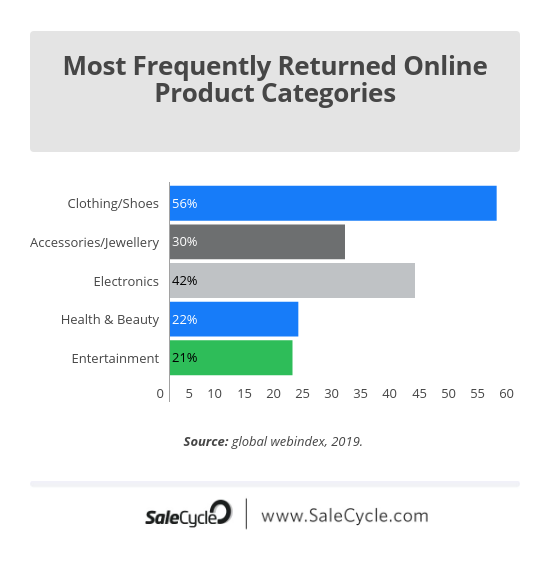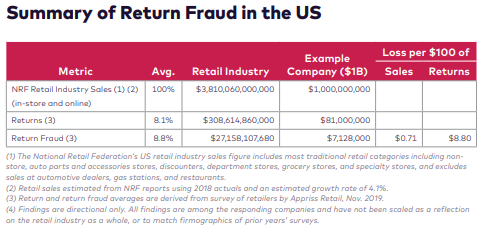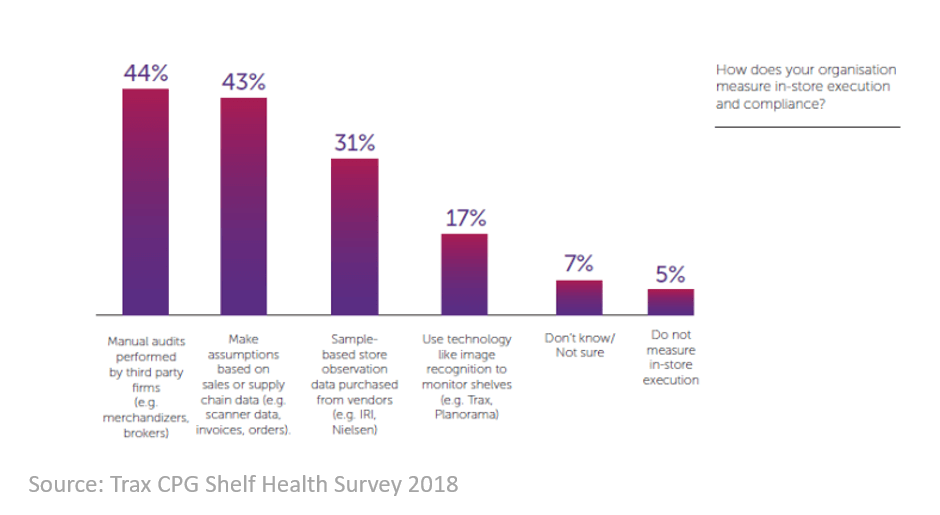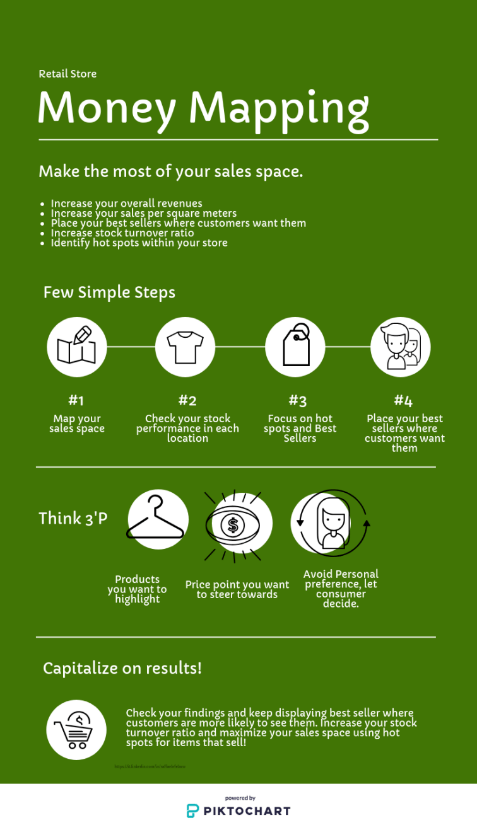What is Smart Shield?
The Detego Smart Shield is a cutting-edge feature that determines the location of individual RFID tags, by using machine learning algorithms. This allows the Detego Platform to differentiate between the backroom and sales floor of a store, without the need for expensive physical shielding installations.
It’s vital that a stocktake tells you not only exactly what is in a store, but where the items are too. The two locations that need differentiating in stores are typically the backroom and the salesfloor. Store staff, and the Detego platform itself, need to be able to see exactly what’s on the sales floor so they can identify when items and specific sizes are running low so they can be replenished from the backroom. If this isn’t done, you can end up with products in stock but not available to purchase on the shop floor – a costly and easily avoidable mistake.
What problem does it solve?
RFID is able to read items from several feet away, and even through objects like boxes and walls – this is what makes it such an excellent technology for managing inventory. What this means, however, is that a staff member doing an RFID-based stocktake in the backroom could accidentally pick up signals from the sales floor, and therefore allocate items to the incorrect location.
The old solution to this problem involved using a physical shield that blocks RFID signals, often in the form of metal sheets or metallic paint. Making physical modifications to a store such as these is both expensive, costing up to $5000 per store, and time-consuming. When it comes to large scale rollouts of hundreds of stores, the added costs and manhours can be a major barrier to entry for RFID.
With the Detego platform, the need for physical shielding is removed entirely, significantly reducing the cost and time to implement RFID in stores. The Smart Shield feature is available out-of-the-box, meaning retailers can implement the cloud-hosted software in stores with very little fuss. This is what makes the Detego platform the most ‘plug and play’ RFID software on the market.
How does it work?
Every RFID tag creates a specific time and signal stamp when being read by an RFID reader – up to several times per second. Detego collects this data (created during stocktakes) and applies machine learning algorithms to determine the most probable location of individual tags.
Explanation of Smart Shield
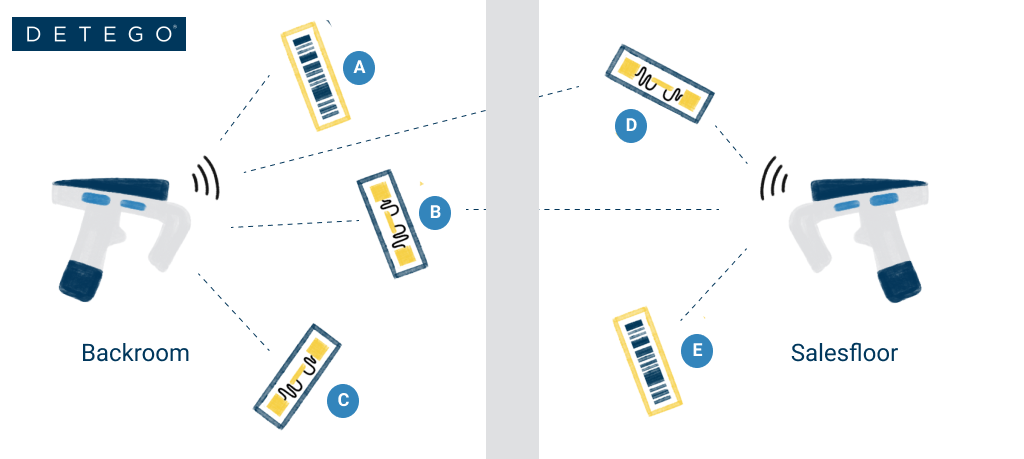
The Detego Smart Shield in Action
The Smart Shield feature makes a massive difference for retailers undergoing RFID store rollouts at scale. These benefits include:
- Determines the location of individual items, with no need for physical shielding between separate stock locations
- Help optimise other processes and features, such as stock replenishment advice
- Allows for faster roll-out and reduces up-front costs, as no physical shielding is required
A Detego customer utilising Smart Shield recently rolled-out the platform in record speed, achieving 100 stores per month and with a stock accuracy of greater than 98%. This speed of implementation is far beyond anything seen before Smart Shield and allows retailers to get up and running quickly to unlock the benefits of the platform, driving an instant return on investment throughout their store network. By achieving high stock accuracy and on-floor availability in stores, Detego customers typically see between 3-10% revenue increase per store.

Cloud-hosted RFID software
Stock accuracy, on-floor availability, and omnichannel applications in stores.
Detego Store is a cloud-hosted RFID solution which digitises stock management processes, making them more efficient and more accurate. Implemented within hours, our multi-user app can provide intelligent stock takes and a smart in-store replenishment process. Later, you can scale the solution to offer omnichannel services and effectively manage your entire store operations with real-time, item-level inventory visibility and analytics.
Webinar: Item-level reporting from source-to store
Digitisation and data go hand-in-hand. As retail supply chains continue to go digital, a wealth of item-level data on the flow of merchandise through the supply chain is unlocked. In the future, the winners and losers of supply chain management will be determined by who leverages this information more effectively.
Join Detego’s Chief Data Scientist, Simon Walk, as he presents the cutting edge of supply chain analytics and how digitisation is taking the guesswork out of retail logistics.
This webinar covers:
• Item-level tracking of Items along the Supply Chain to deliver accountability, visibility & traceability
• Effective traceability which combats supply chain shrinkage and counterfeit products.
• Using heuristic & Machine Learning based Algorithms to detect supply chain irregularities.
• Using dwell-time data to optimise operational & Supply Chain processes
• Analysing throughput data across factories, DCs and stores
Online returns have been a challenge for retailers since the beginning of eCommerce. This is because of both their volume compared to normal stores, and the costs associated with processing them. In the wake of COVID-19, this problem could prove more critical then ever, as online becomes retailers’ singular sales channel. There is already early evidence of this, with preliminary data from Quantum Metric showing that eCommerce associated with Brick and Mortar retailers saw an average revenue weekly growth rate increase of 52%, and Nike Inc.’s digital sales went up by 36%.
The eCommerce returns dilemma
Online shopping is popular for a reason, but the convenience and choice of eCommerce comes at the price of not being able to ‘try before you buy’ for customers.
This simple difference is the reason online returns are so much more prevalent than for Brick and Mortar stores. In eCommerce the customers’ homes becomes the fitting room. And, just like any fitting room, products end up back on the shelves. According to Happy Returns, while shoppers return only 10% of what they buy in stores, they send back up to 50% of what they buy online.
This is compounded by customers accounting for this when ordering online. A survey from Barclays found that 30% of shoppers deliberately over-purchase and subsequently return unwanted items. Additionally, 20% regularly order multiple versions (often sizes) of the same item so they could make their mind up when they are delivered, all of which is facilitated by the retailer at great cost.
While it might seem logical to have stricter returns policies, or make customers cover the cost of returns, consumer expectations make this a risky strategy. According to the 2017 UPS Pulse of the Online Shopper survey, 68% of shoppers view returns policies before making a purchase. This leaves retailers with a catch-22 situation when it comes to losing out on online sales or losing profits from processing the inevitable returns that comes with those sales.
What are the challenges of retail returns?
So why are returns such a strain on retailers?
Cost of returns – First and foremost is the simple cost of returns. Since returns are in themselves essentially lost sales, the added cost of returning them, which according to CNBC is on average 30% of the purchase price, can heavily impact retailer’s margins.
Processing returns and reverse logistics – On top of this is the resources and effort of processing returns and getting the stock back available to be sold as quickly as possible. This reverse logistics can be particularly challenging and can result in returned stock not being available for purchase again for some time, often leading to out-of-stocks on the webshop. According to the Barclays report, 57% of retailers say that dealing with returns has a negative impact on the day-to-day running of their business.
Contamination concerns with COVID-19? – A unique and recent challenge, particularly for apparel retailers, is dealing with the potential contamination and contact of returned good with the COVID-19 virus. Initial research suggests that the virus can only survive on fabric surfaces for 24 hours, but for up to 72 on plastics like packaging. This will need to be addressed by eCommerce retailers who continue trading throughout the epidemic.
Return fraud – This is a challenge shared by brick-and-mortar stores. Fraudulent returns cost the US alone 27 billion dollars a year. This can involve the ‘returning’ of stolen merchandise for cash, stealing receipts to enable a false return or using someone else’s receipt to return unpurchased store stock. Naturally, using receipts for returns presents a risk, APPRISS found that receipted returns are more than twice as likely to be fraudulent as other methods.
How to reduce the impact of returns on eCommerce
So what options are there for retailers looking to tackle their returns problems?
- Reduce the likelihood of returns, without harming customer experience or sales: Include accurate and detailed product descriptions. Use uniformed/standard sizes where possible and provide a more specific sizing filter. Offer virtual ‘try-ons’ with augmented reality/3D imaging.
- Set clear and accessible rules regarding returns: Make sure customers know what and how they are allowed to return items, this reduces spending resources processing illegitimate returns.
- Improve visibility: Maintain a single view of stock with item-level inbound and outbound processes, this will also allow for online returns back to stores, and ship-from-store. Make this visibility accessible to your entire team and your customers.
- Improve efficiency of inbound and outbound processes: Utilise reliable & efficient technologies and automated processes like exception handling. One of the leading technologies for this is RFID, which prevents the need to open any boxes or packages as it can count and verify items without direct line of sight.
- Improve internal processes: Ensure returns processes (and supporting software) enables additional layers of merchandise management such as grading items based on quality and tracking when the item was returned.
- Counter Return Fraud: Verify legitimacy of returns as much as possible, best practise involves unique item-level validation like RFID or unique serial numbers.
- Ensure returned stock is safe to sell: Implement processes to ensure returns are not damaged in any way, implement a policy to account for safe handling of merchandise during theCovid-19 pandemic, either sanitising products or leaving them a set amount of time before adding back into webshop stock.
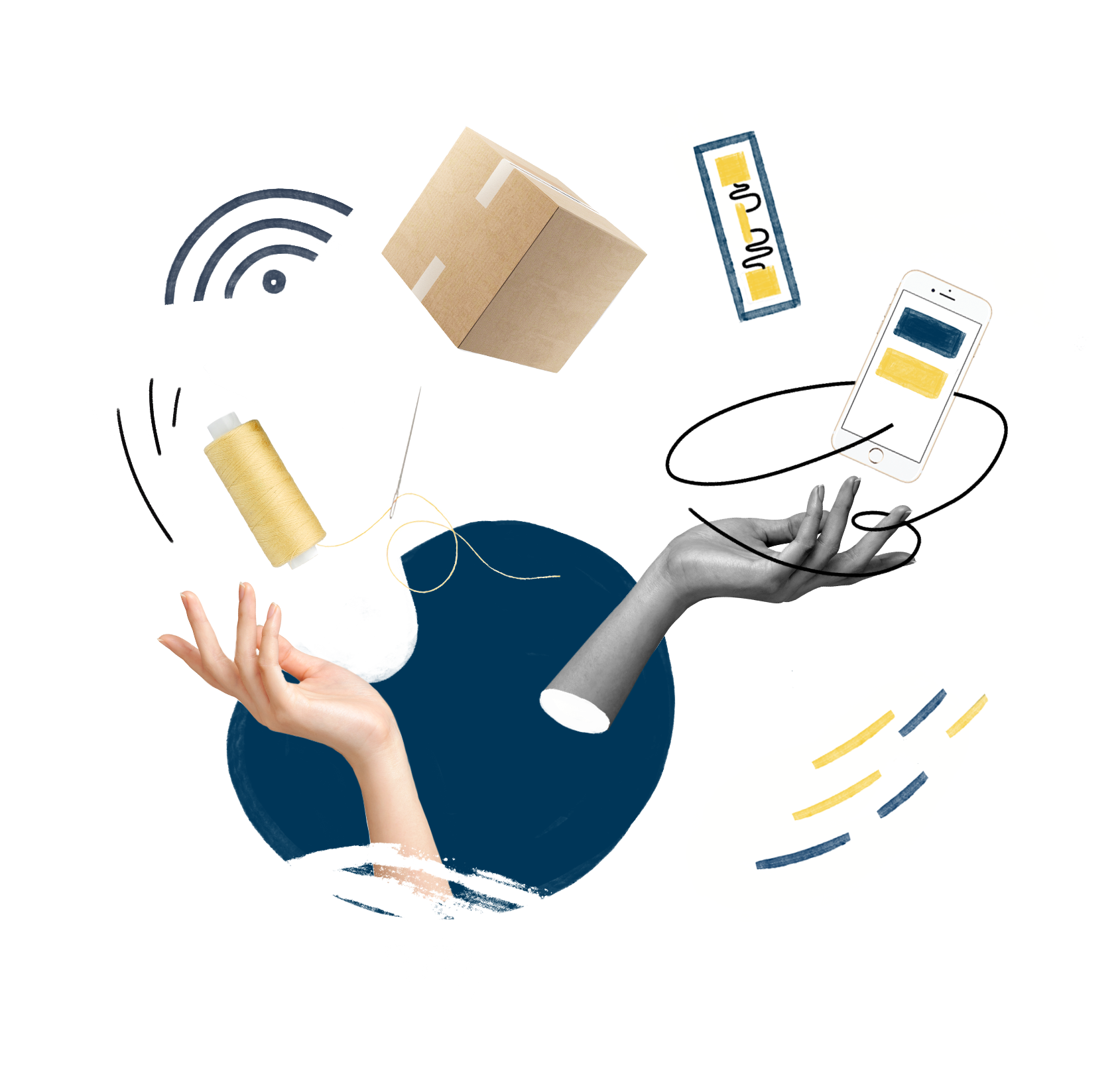
Using RFID tagging and looking to improve return processes?
NEW: eCommerce returns module
eCommerce/ DTC is increasing due to COVID-19. This causes an over proportional increase in returns which normally would require a ramp up of staff and equipment to handle the process – Detego’s new RFID enabled return process provides an approx 90% productivity increase.
Want the latest retail and retail tech insights directly to your inbox?
Visual Merchandising’s Data Problem
Visual merchandising is one of the ‘dark arts’ of retail. For the uninitiated, it’s the practice of designing visually appealing sales floors and store fixtures that attract customers and ultimately sell the products on display. It’s a subjective and artistic means of delivering a concrete KPI – sales.
One of the challenges of visual merchandising is data, experimentation & design is all well and good, but not if you have no way of knowing what does and doesn’t work. Sales data is always a good place to start, but there are so many other factors at play that it’s often unwise to attribute visual merchandising to an increase or decrease of sales to a single product. You have to go one step further…
What is Money Mapping?
So, how do you measure the sales performance of a store based on its layout and design?
First, you map out the sales floor with the exact location of products. Then you break the map of the store into ‘zones’, typically around certain fixtures, shelves and displays. These zones can consist of several different items, grouped by either category or style depending on the design of the store.
You then collate the sales of every item in this zone and compare it to others in the same store. The result? An impression of shop floor sales broken down by areas of the store.
This is called ‘Money Mapping’ and allows retailers to visualise and analyse which areas of a store are ‘hotspots’ and which are ‘cold’ in terms of sales. This gives an initial view of which areas and fixtures are selling products and which aren’t.
To account for other external influences on sales, best practise is to swap items between fixtures or observe a ‘money map’ over a long time, as collections and merchandise changes between seasons. This way, if the localised sales data remains relatively similar even after products have rotated, then it’s clear the design or locations of the fixture is having an impact.
What are the benefits of Money Mapping?
- Insight on consumer experience
- Provides valuable data for visual merchandisers
- Breaks down areas of sales floor by sales performance
- Can be used to optimise store layout
- Drives Sales
- Can compare Product Placement & Visual Merchandising
- Can be used to conduct A/B tests
This all sounds great, so why doesn’t every retailer and every store do this already? The simple answer – the process of matching the sales data to specific locations on the sales floor, manually for every item and every store, is logistically a big ask. This means, if this can be done at all by visual merchandisers, it can only be done in a small number of stores.
How does AI change money mapping?
So how can we solve this data problem for visual merchandisers and make ‘Money Mapping’ easier and more accessible for retailers?
The first issue is having an accurate map of a store which includes exactly where every single item is sold from. Traditionally this would have to be done manually, and then have the sales data of items cross-referenced with their location in a store.
The solution: Using RFID (Radio Frequency Identification) and AI localisation techniques, we can now create a map of a store as part of the daily or weekly stock count.
This is done by adding ‘reference’ RFID tags into the store. Small tags just like ones that go on products are placed on fixtures and walls in the store. Because these never move, we can use the signal strength (relative to the fixtures) from stock counts to map exactly where items are in the store and what items they are grouped with.
This location info is then integrated with data from point of sale to generate an automated Money Map of a store, as part of the regular reporting and analytics function of the store. This can be done for as many stores as desired. With the data collection automated, visual merchandisers can focus on using the data to optimise product placement and store design across stores.
With larger data sets to work with, this also opens up the potential for more detailed analysis and experimentation such as A/B testing product combinations and store layouts!
What’s the process for AI Money Mapping?
- Attach reference RFID tags to walls and fixtures within the store
- Perform regular RFID stock takes as normal
- Software uses machine learning to ‘map’ out item locations within the store
- Integrate point of sale data with RFID software
- Software produces ‘heat map’ of the store based on sales
- Visual merchandisers can use data to inform strategy and measure results
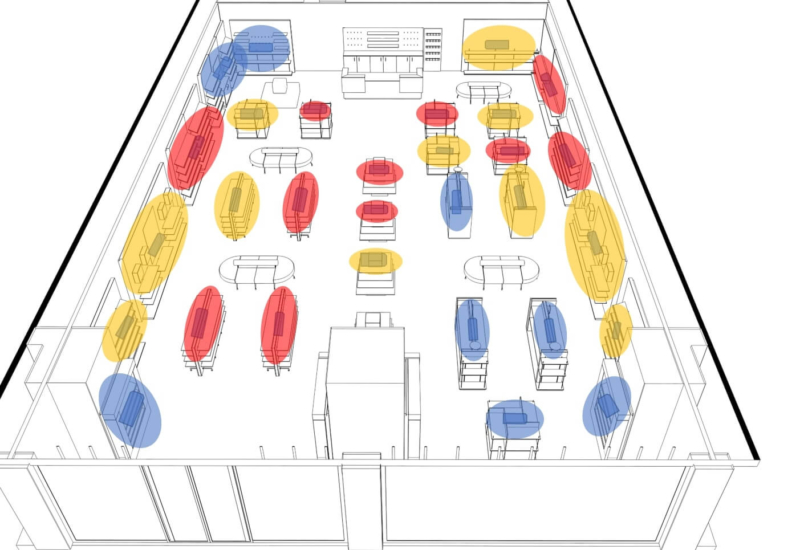
Conclusion
Visual merchandising is a subtle but valuable process for retailers. Done properly it has a huge impact on both sales, customer experience and brand image. The only problem with this is visual merchandisers often don’t have enough data to measure performance and identify where their attention is needed most. The data they can collect is either time consuming, expensive or inaccurate.
Artificial intelligence changes the game for visual merchandising. By utilising RFID tags and Machine Learning, it is possible to ‘map out’ the location of items in a store, and more importantly, the sales distribution of the shop floor. These ‘Money Maps’ tell visual merchandisers what areas of the sales floor are ‘hotspots’ for sales and which are underperforming. Using this data, they can then focus their attention on improving the design or layout of certain areas.
Additionally, with this data stores can look to leverage their sales hotspots either by prioritising the best locations for best-sellers, high-value items or items that are due to go out of season.
Either way, AI-enabled Money Mapping is another important evolution in retail data and analytics. Providing retailers with unprecedented insight into exactly what goes on in Brick and Mortar Stores.
Want the latest retail and retail tech insights directly to your inbox?
(For an introduction to combining AI and RFID see this article)
When it comes to using Artificial intelligence (AI) and Radio Frequency Identification (RFID) in retail for process optimisation, the majority of use cases involve management or ‘HQ’ level decision making. These include automating functions such as store planograms and stock optimisation between stores.
However, AI can also impact retail on a much more micro and everyday level, actively assisting store staff in one of their most common daily routines –stock replenishment.
Using RFID and the information it collects from stock reads, we can produce AI pick lists to optimise and guide staff through the replenishment process. Not only are we combining RFID technology and AI algorithms to produce these pick lists, but existing RFID processes are already assisting staff. When you put all this together, replenishment become a walk in the park.
Let’s start at the beginning…
RFID-based Stocktake and Replenishment – The backbone of modern stock management
With RFID, store staff can do regular (often daily) cycle counts of the entire store quickly and easily. This is simply done by walking around the backroom and salesfloor with a handheld reader that counts items that are several feet away, using radio frequency. An RFID application or software, like the Detego platform, will then compare the actual stock levels of the shop floor with the desired counts (i.e., planogram), and tell staff exactly what needs to be replenished from the backroom.
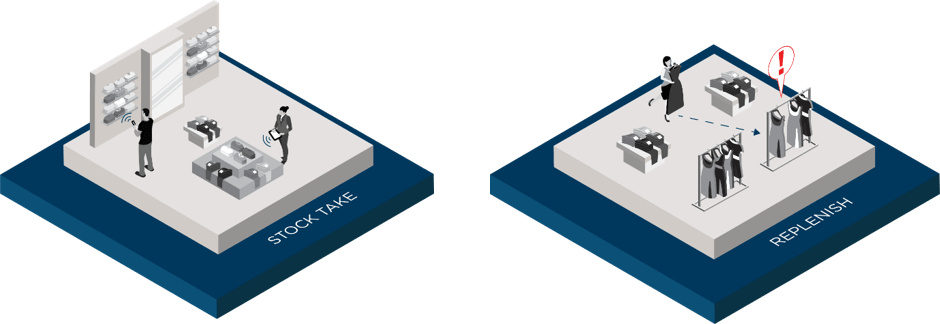
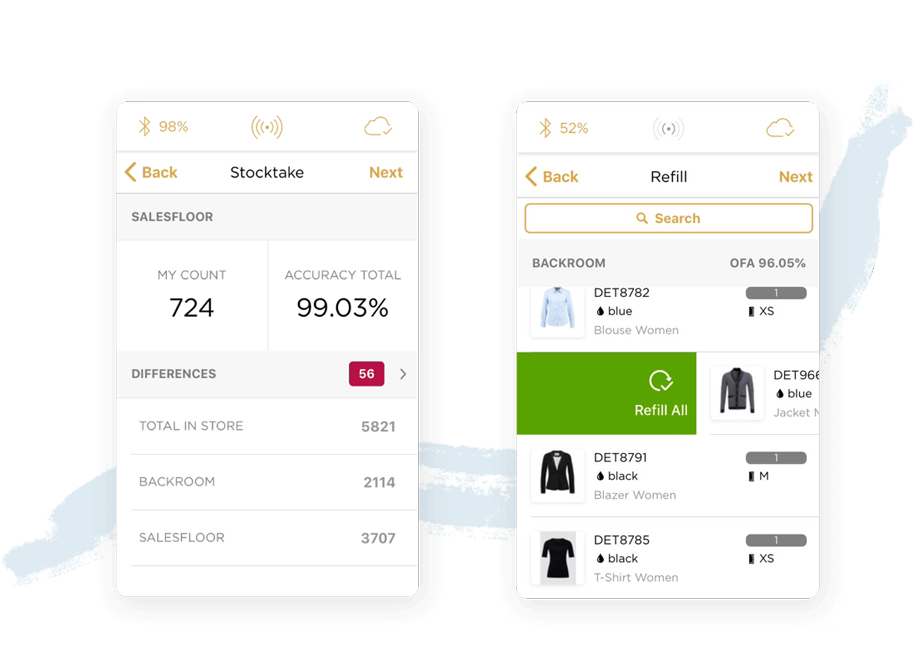
So far, what has just been described has been entirely RFID-based and is the standard process for RFID in retail. This is already far easier and more accurate than traditional methods, not to mention the actual effect of the technology like higher stock accuracy and product availability. But why stop there?
Taking it one step further – AI pick lists for ‘mapping’ the perfect replenishment path
Normally, even with the support of RFID, the store staff are then left to fulfil replenishment by themselves, using the list provided by the application. These pick lists are often only sorted by product features such as name or price. Because back rooms can be quite large in bigger stores, or densely packed in smaller ones, the staff’s ‘pick path’ can be incredibly sporadic. This is made even worse in the case of new staff who don’t know the layout of the backroom by heart, or even experienced staff if stock has simply been moved around and updated with the start of a new season.
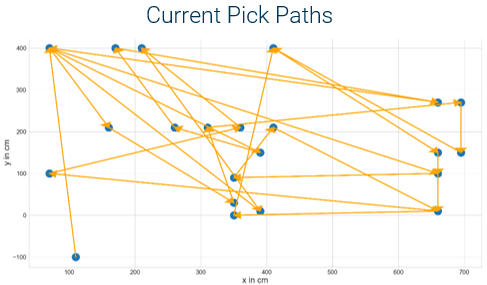
By utilising new tag localisation techniques, it is now possible to locate where items are in the backroom in relation to each other. This is done during the regular RFID stocktakes that are already taking place, utilising data mining and machine learning pipelines without any need for additional hardware or specialist tags. Using this information, we can create automated AI pick-paths that, using a mobile application, guide staff through replenishment and present the most efficient order to collect items in.
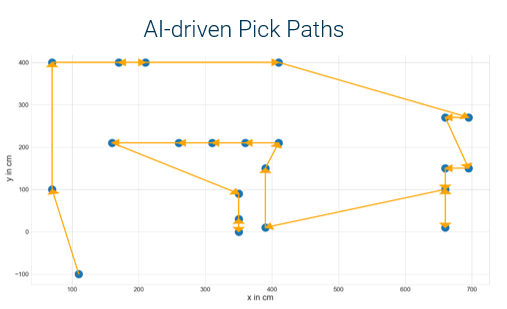
The above example is designed to present the quickest possible replenishment route for staff, so is solely using items’ distance from one another to calculate a pick list. However, AI pick lists can process the replenishment list in a number of ways, depending on what the store wants to focus on.
Replenishment paths could take additional factors such as product value or expiry date into account, alongside the location of the items. It would then look for items that fit this rule and are nearby one another in the backroom. For example, a pick list targeting on-floor-availability would group nearby items that are running low on the sales floor, so that these items are refilled first to speed up the replenishment process whilst also combatting loss of sales from out of stocks.
Benefits of AI-pick lists
Artificial intelligence, the future of smart retail or another empty buzzword?
Artificial intelligence is the poster child for emerging or ‘new age’ smart technologies. Whilst it’s easy to get carried away with ideas of intelligent robots, AI mostly involves intelligent automation systems. This means computer systems that can process and respond to information by themselves, and even learn and self-correct better ways of doing so over time. AI is a broad spectrum, however, and the complexity and ‘intelligence’ of such systems can vary.
AI’s main use for retailers is to automate analysis and decision making
Because AI is still in relative infancy for retail, a large proportion of its use cases for the industry are still being developed and established. We have already seen a strong uptake in AI for customer intelligence in the form of online chatbots and product recommendation engines.
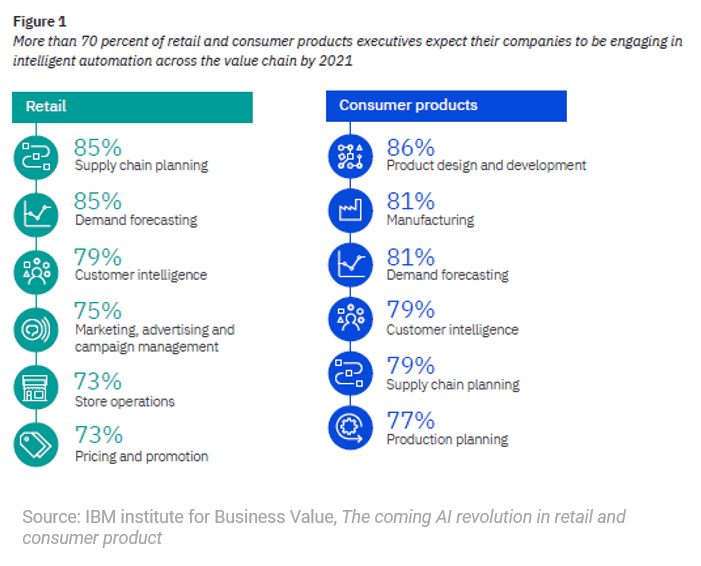
The other areas of potential, namely optimisation of business processes like supply chain planning, demand prediction and store operations, are beginning to take shape but all share a common problem – they need large amounts of data. This has been the main thing holding AI back in certain areas of the retail value chain, but by utilising another technology becoming increasingly common in the industry, this could all change…
RFID in retail, the story so far:
If the ‘AI revolution’ hasn’t really taken off yet, the RFID one is well underway. RFID is used in retail to track and manage merchandise, on a single item-level, with far greater detail and accuracy than traditional systems can manage. The key benefit of RFID for retailers is an accurate and single view of stock across the entire business and its supply chain.
Naturally, RFID systems produce a huge amount of data for products, both in the supply chain and in the individual store. If only there was something that could process all that data…
AI meets RFID: The perfect match
Combining the large amount of item-level data RFID produces with the automated processing power of AI is the natural next step for retail technology.
The key to doing this is each use case adding value or actively solving a problem. At Detego we often talk about ‘avoiding data for the sake of data’ so when using AI to process such data, producing actionable insights and recommendations is vital.
So, what can we do by utilising AI with RFID, and why should retailers care?
So far, the key areas RFID-driven AI automation offers value to retail operations are assisting store staff, assisting customers and optimising inventory management on both a single store scale and across entire store networks.
Our Data Science team are developing solutions for the following use cases, which we will explore in detail in future articles:
Webinar Recording: Combining AI and RFID Taking Retail Inventory to the Next Level
Artificial intelligence (AI) is becoming increasingly utilised within the retail industry. One of the main challenges with the technology is having enough relevant data to be utilised or ‘fed into’ an AI system. With Radio Frequency Identification (RFID) providing huge amounts of accurate item-level data for merchandise, the two are a match made in heaven.
This webinar cover AI’s applications for stock optimisation and how machine-learning can ensure products are always in the right place at the right time, including:
- AI-driven, automated planograms for optimised product availability
- Visual merchandising and ‘Money mapping’ in stores to monitor and increase sales.
- How RFID stock-takes and AI pick-lists combine to make replenishment faster and more accurate than ever
- How machine learning smart fitting rooms are bringing accurate cross-selling into the physical store
- Using AI for demand prediction and stock optimisation across store networks
Event Overview
Digitally native competitors and demanding customers are forcing a new perspective in retail. Artificial intelligence and machine learning have huge implications for technology and is one of the main driving forces of the ‘fourth industrial revolution’. The AI in retail conference explores how this fast-emerging technology is changing the retail landscape.
The event takes place on the 16th of October at Cavendish conference center in London (W1G 9DT).
With speakers from several major retailers and brands including Sainsbury’s, Domino’s, Microsoft and google, as well as our customers Levi’s, the conference promises to be incredibly insightful on the practical applications of AI in retail.
Presentation: AI for inventory and stock optimisation – ensuring the right products are in the right place at the right time
Our senior data scientist, Simon Walk, will be discussing how the Detego platform offers AI capabilities to retailers as part of a SaaS solution. The presentation will cover AI’s applications for stock optimisation and how machine-learning can ensure products are always in the right place at the right time, including:
- How Artificial Intelligence works for stock optimisation
- AI-optimised planograms – How AI and machine learning can be utilised to produce more up-to-date and relevant planograms that are optimised for each individual store
- Machine-Learning Product recommendations – How AI is used to provide superior product recommendations to customers to increase sales, and how Detego utilises this technology in smart displays to bring cross-selling to brick-and-mortar stores
- Smart Picking Lists – How AI can take stock replenishment to the next level by guiding staff through replenishment with optimised ‘picking paths’ that calculate the most efficient replenishment route for store staff
Who should attend the AI in retail conference?
The event is aimed at senior executives within retail in the following departments:
- Digital Transformation
- eCommerce
- Data Science / Data Engineering / Data Analytics
- Technology
- Innovation
- Sales & Marketing
- Insights
- Customer Services
- Product
Coming to the conference and want to schedule a meeting? Get in touch below:
The retail industry has been subject to enormous change in recent years, a trend that looks likely to continue even now retail has found its feet in the digital age. This significant shift in the landscape coupled with the collapse of numerous household brands naturally created something of a panic in the industry and a fear an impending ‘retail apocalypse’. So, has this taken place and are brick and mortar stores heading toward extinction in the age of online shopping? The short answer: no. Retail sales, in general, are increasing, and whilst online sales are certainly growing at a faster rate than in stores, in the UK market Brick and Mortar stores make up roughly 84% of all sales, a trend that applies globally.
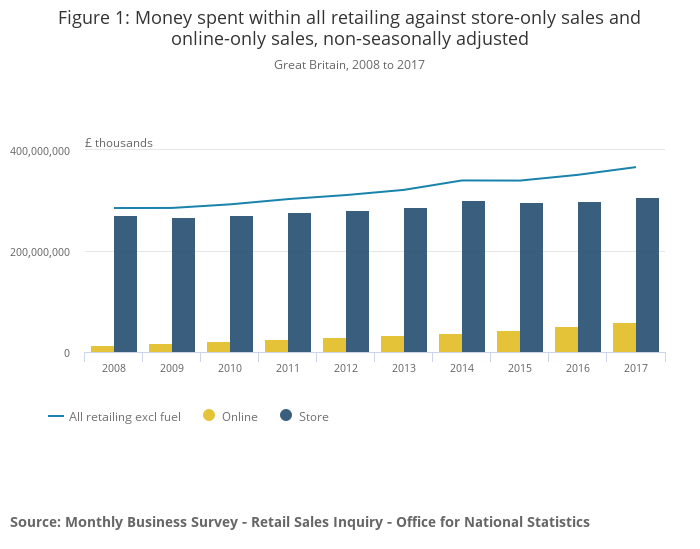
In fact, with the help of new technology, in particular, AI brick and mortar stores can take lessons from e-commerce and bring new innovations into the physical store. A study by Capgemini found that around 68% of pure-play online retailers have implemented artificial intelligence in some fashion, compared to only 10% of brick and mortar stores. Utilising new technology can often be the key to growth, so perhaps it’s no surprise that online retailing is growing at such a faster rate. This is beginning to change however, as physical stores are learning to adapt.
AI-assisted cross-selling in the store
The ability to cross-sell using AI is a huge strength of online retail. Online stores use machine learning to make intelligent and tailored product recommendations to customers while they are shopping This naturally increases sales, but does so relative to the quality of the product recommendations, hence the use of AI to perfect the process and make more successful recommendations. Brick and mortar stores have traditionally never been able to make use of cross-selling like this, having to rely on in-person customer service to drive sales. But as technology has improved, they can now make use of both.
The main reason for this is the emergence of chatbots as a mobile platform for in-store product recommendations. Whilst chatbots themselves originate from online, certain retailers now implement them in their stores to assist customers. Their primary function is often to assist customers if store associates are all occupied. Chatbots can help customers locate items, find more information on products and check stock availability, all through their smartphones. Intelligent AI-powered chatbots will then be able to recommend products similar to the item’s customers were searching for, not only increasing sales but improving the customer experience.
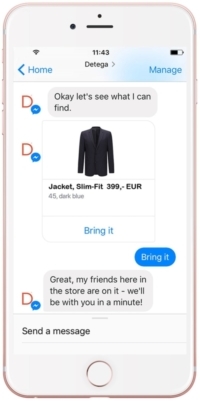
The fashion industry has taken this concept even further with the use of smart mirrors. Smart mirrors use advanced tagging technology (RFID) to sense the items that a customer brings into a fitting room. It will then display the products on the mirror and, like a chatbot, assist customers by providing information on other available sizes and colours and recommending products that are often bought with the ones being tried on. Most smart mirrors also have a feature that calls store staff to assist the customer, either providing face-to-face support or bringing the recommended items the customer has chosen to the fitting room. Smart fitting rooms are the epitome of the merger of the digital and physical in brick and mortar stores.
AI-powered in-store business intelligence
Artificial intelligence can also go a long way to revolutionising traditional brick and mortar store processes. One of the best examples of this is the use of AI assisted planograms. A planogram is essentially a plan of where items should be displayed on a shop floor to maximise customer purchases. In certain sectors such as fashion, planograms must be even more detailed and include the optimum display quantities of each different size and colour.
Artificial intelligence can revolutionise the planogram, using machine learning to constantly optimise not only the positioning of merchandise but the most efficient quantities of different articles to display on the shop floor. The advantages of this process being performed through AI are huge. Not only does it largely automate the process, saving time for staff, but it will constantly adapt and improve and can personalise and optimise the planogram on an individual store level.
The future of retail, online and in-store
To conclude, the impact of digital technology on the retail industry, in particular brick and mortar stores, has been significant but not actively catastrophic as many feared it would be. The emergence of ecommerce has gone from a threat to a strength for some physical stores. Not only has omnichannel retailing (something we did not have time to explore, but we go into detail on here) allied the different methods of shopping, but brick and mortar stores have now begun to incorporate certain technologies from online.
AI technology, originally something only online retailers could really utilise, is now finding its way into brick and mortar stores and improving both store processes and customer experience. We are also just scratching the surface of AI’s uses in retail and as more retailers choose to adopt the technology more benefits will be discovered. So, in reality brick and mortar stores are far from going extinct; they are in fact evolving and will continue to do so.
(Originally published on AI Business.com)
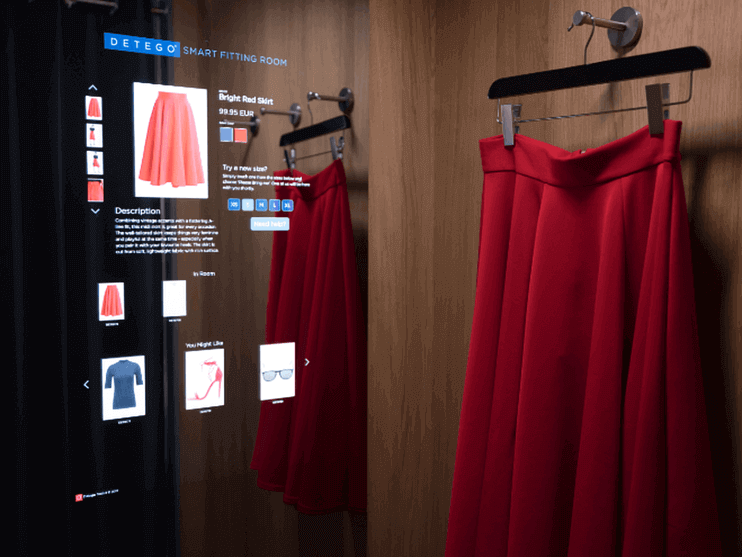
Did we spark your interest?
Retail software specialists, Detego, have presented their ground-breaking methodology for in-store product recommendations, helping bring the same quality of cross-selling over from e-commerce and into the physical store. The new AI-based recommendation engine will enable retailers to provide personalized product suggestions utilizing data unique to store locations and point of sale information, without the need for identifying customer profiles.
Cross-selling through related product recommendations has always been a huge strength of e-commerce, with 35% of Amazon’s revenue generated by its recommendation engine (source). In recent years, innovations in RFID-based solutions such as smart fitting rooms and mobile chatbots have opened the doors to automated product recommendations within physical stores. Whilst the technology is now available, there is still one more hurdle between Brick and Mortar stores and effective cross-selling. This is namely the fact that the best recommender systems require vast amounts of both personal and aggregated data to provide effective suggestions, and whilst this is at a surplus in e-commerce, physical stores traditionally struggle with data being limited as well as sparse.
Speaking at the ACM UMAP 2019 in Cyprus in June, data scientists from Detego, who specialise in RFID-based software solutions for retailers, presented their proposed method of data-manipulation for in-store recommender systems with a paper titled: ‘Beggars Can’t Be Choosers: Augmenting Sparse Data for Embedding-Based Product Recommendations in Retail Stores’. The approach involves an alternative algorithm that leverages shopping-baskets and common-item combinations combined with point of sale information. Detego says this allows retailers to provide targeted recommendations with a 6.9% increase in quality, aimed at individual stores, without having to maintain separate models for each location. When combined with the technology to deliver these product recommendations, retailers could see a substantial increase in sales in Brick and Mortar stores, whilst customers will see a more connected and engaging in-store experience, as Detego continues to bridge the gap between online and the physical store.
“Customers who bought this also bought…” is no longer a phrase reserved exclusively for customers of e-commerce platforms. Due to the adoption of RFID-based technologies, such as Detego’s Smart Fitting Room, personalised recommendations can also be presented to customers of brick and mortar stores. Moreover, Detego’s AI-based recommendation engine is tailored towards the specific requirements of fashion retail stores, such as fast-changing and varying product assortments.’ says Matthias Wölbitsch, Detego data scientist.
With Detego now successfully rolling out the Smart Fitting Room application alongside their real-time inventory management software, this latest improvement is another opportunity for retailers to evolve their stores for the future.

